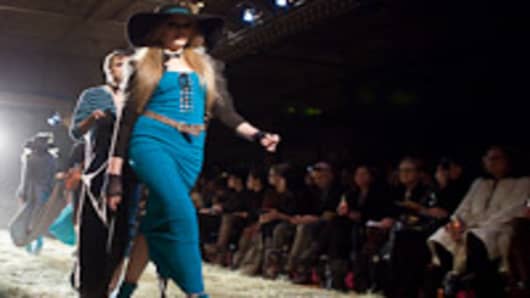1. Disco Fever
Prabhakar: Most of the collections had an element of 1979 style. High-waited trousers, blousy tie shirts and accessories were a common theme.
They were often paired with oversized sunglasses on the runway. Accessories such as fold over pocketbooks and wedge heels were an integral part of all the collections, getting as much attention as the clothing themselves.
Hartman: Department stores will carry a limited assortment of the high-waisted pants. I'm not sure there will be sufficient consumer interest in them. But, luxury retailers will move them.
As for the accessory play, that's a quicker turnaround if a style emerges or items need to be reordered.
Expects Neiman Marcus and Nordstrom to continue to benefit. Likes fast and forward fashion from Forever 21. It could benefit if something emerges (like a shape of a handbag or style of shoe.)
2. "Nothing comes between me and my…. "
Prabhakar: High-end denim was staple on the runway. No cutting corners here. Luxury material was used.
Hartman: Luxury denim should be fine if the stock market is doing well. But, increased cotton costs could likely depress mid-priced denim area.
3. Pajama Jeans, Too?
Prabhakar: Skinny jeans and jeggings were still a main trend on the runway. But, unlike past collections, the jeans were cropped, darker and more tailored. All the looks had a luxe look and feel to them.
Hartman: The lower end mass market for the skinny jeans and jeggings will continue. Wal-Mart, Kohl's and K-Mart will benefit.
Due to rising cotton prices, we'll see more cropped styles. Not only have jeans and pants gotten skinnier—hemlines are coming up, too.
Also, watch out for lowered thread counts. Designers are trying to manufacture something that can be sold at a price point that won't shock the consumer.
The same kind of thing is happening with high-end men's "the European cut" suits. If designers cut an inch or two out in the width or length, they save money.
4. Paint By Number
Prabhakar: Designers moved away from the typical drab slate grey, black and beige colors of collections past and focused on bright colors such as tangerine, cerulean blue, magenta and emerald green.
Hartman: JCPenney has one of the quickest sourcing responses and should be able to react to the colors. Overall, the department stores are in good shape here.
5. "Fur" Real Or Not
Prabhakar: Fur was a major trend on the runway.
Hartman: If the stock market does well this fall, luxury will, too. We are seeing synthetic furs in colors that could be a much more affordable and PETA-friendly choice.
Stephanie is Squawk Box producer and senior NetNet retail correspondent. Follow her on twitter @StephLandsman
______________________________________
Questions? Comments? Email us atNetNet@cnbc.com
Follow NetNet on Twitter @ twitter.com/CNBCnetnet
Facebook us @ www.facebook.com/NetNetCNBC



